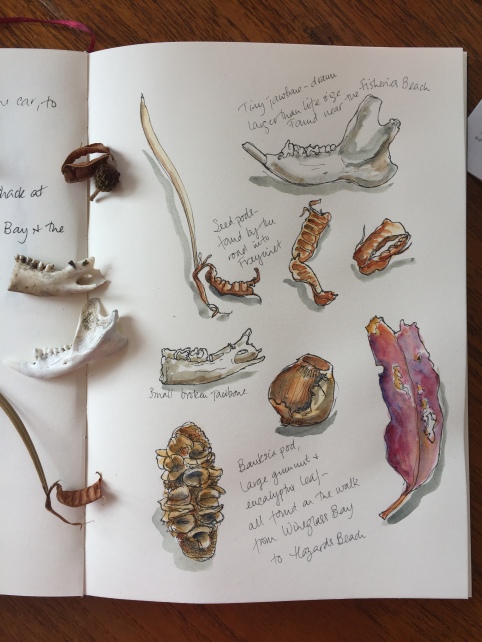
In the middle of December I flew down to Hobart to join my partner who had taken the car over on the ferry a couple of weeks before, as he had work to do at the University of Tasmania in Hobart. After a few days there, of course visiting the wonderful MONA (Museum of Old and New Art), we spent a week in a friend’s beach ‘shack’ in Freycinet National Park, one of the most beautiful places in Tasmania. We walked – one walk that we HAD to do was a climb up to look down at Wineglass Bay, then down the other side, a long loop across a marsh, another beach and through the bush back. About 11 km it took us 5 hours and was a good workout, but worth it!
On other days we drove to walk on the Friendly Beaches – the sea intense turquoise blue and sand white, with rock pools at the water’s edge, The Gardens with the same coloured ocean and sand, but massive boulders covered with orange lichen … and numerous others. In between we relaxed, read and I drew. From Freycinet we moved up the coast to St Helens, a small fishing town in the Bay of Fires, then camped at Policeman’s Point a bit further up the coast, still in the Bay of Fires. A beautiful spot for bush camping and walking on the beach until it rained … but we weren’t daunted and took ourselves to Bridport on the north coast. An unexpected delight, the coastline composed of numerous small beaches bordered by rocks. And the sun shone again!
Our last stop was Launceston, another pretty small city, hilly like Hobart, with elaborate Victorian architecture. We watched the New Year fireworks from a park by the Tamar River – a delight to be so close and walk back to our hotel in a matter of minutes, very different from Sydney! On the ferry back to Melbourne we had a very comfortable cabin, the Bass Strait was a millpond, so a simple and uneventful (thank goodness, I am a very bad sailor!) trip. Then towards home, catching up with friends along the way.
I only had time to sketch between Freycinet and Bridport, but took every opportunity I could, walking around with my eyes on the ground looking for any attractive little object!

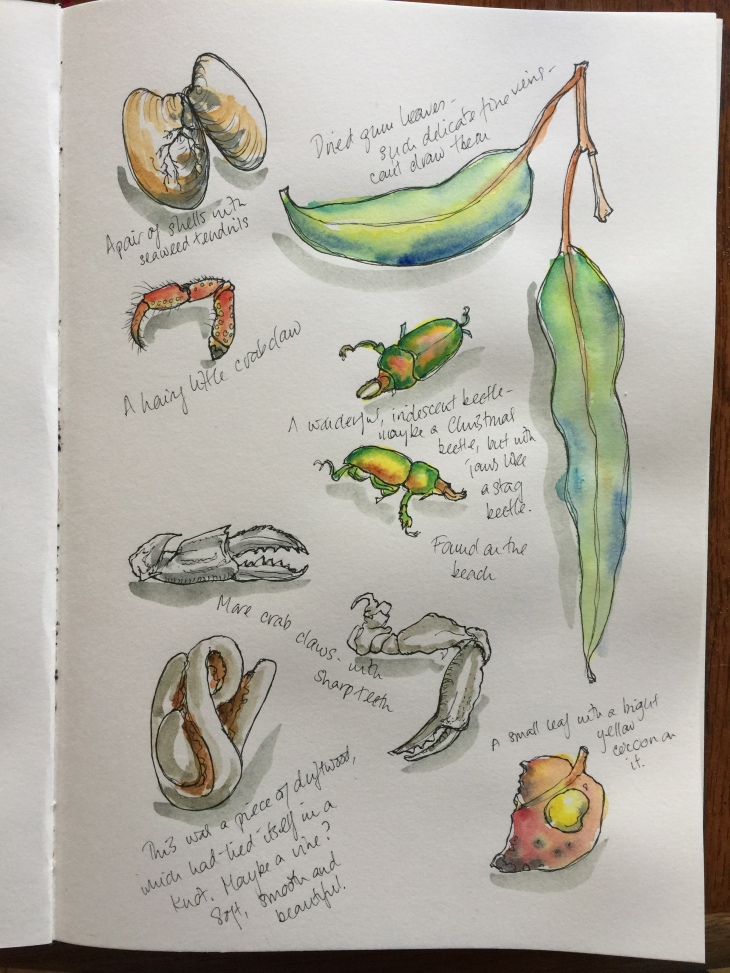


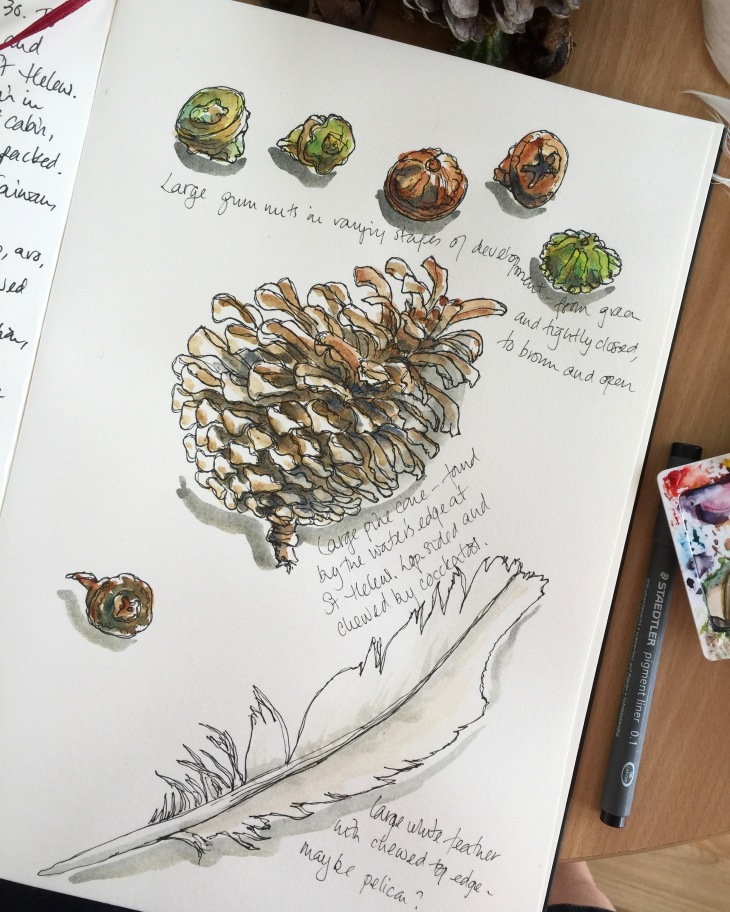
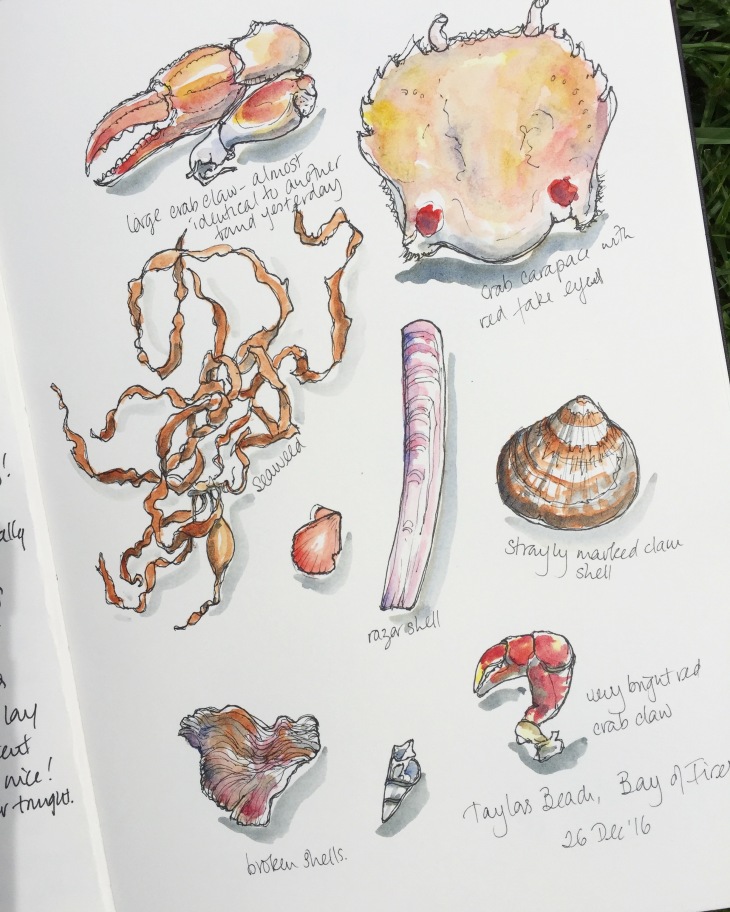
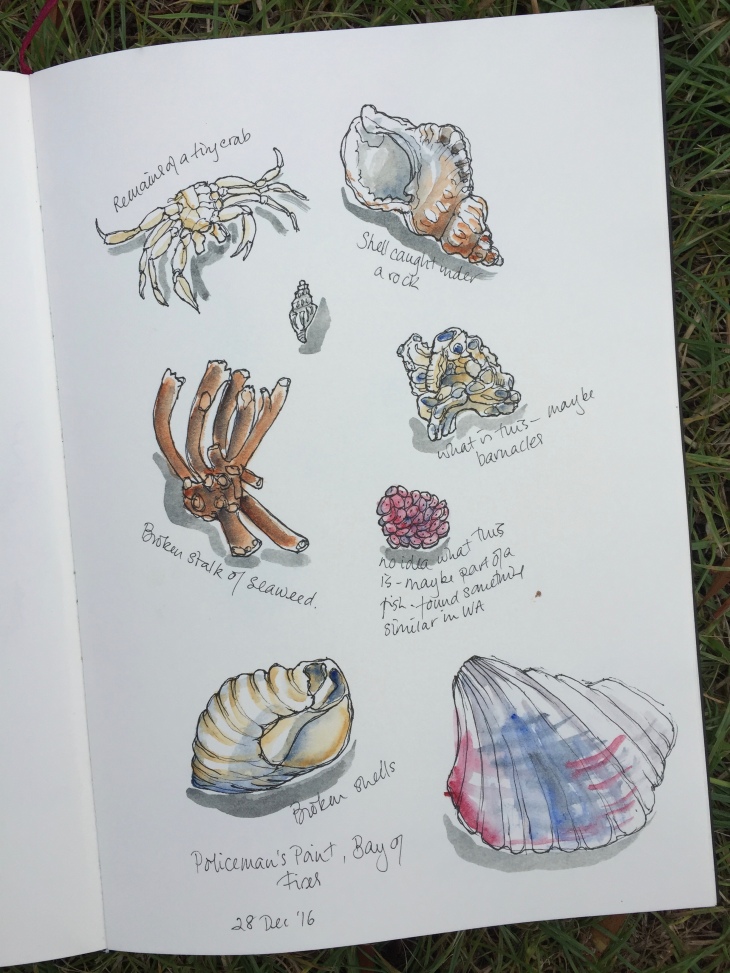
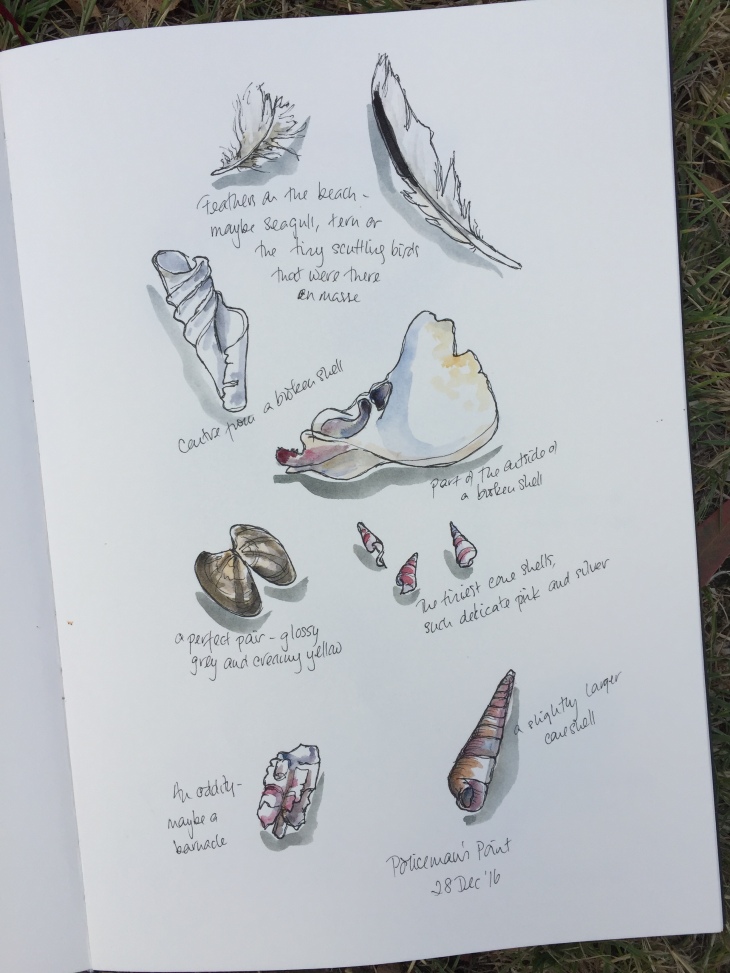

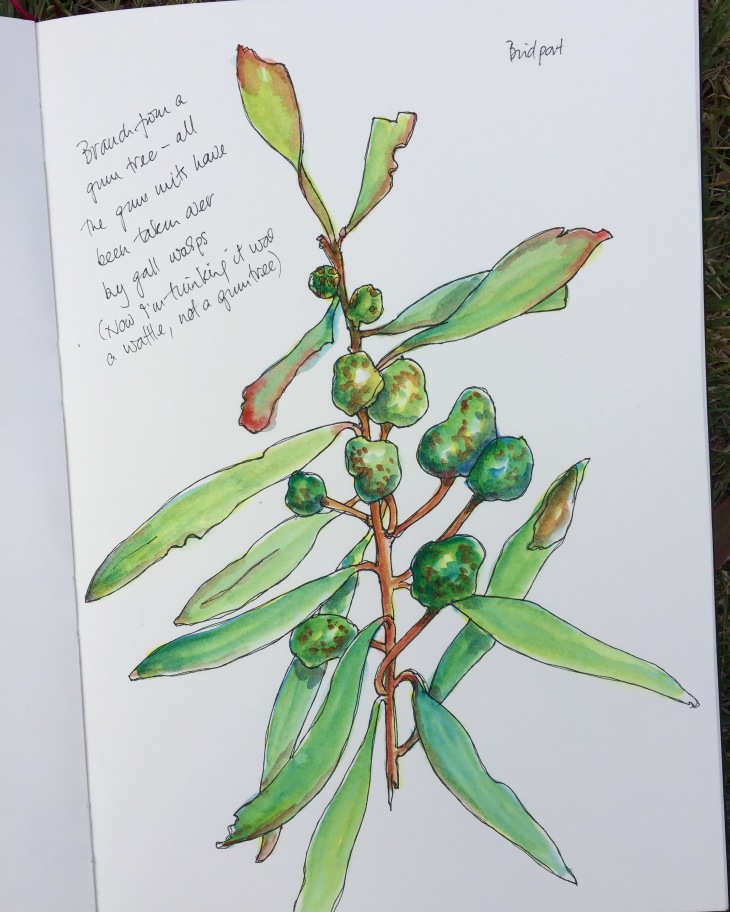
These are so beautiful Anna – so wonderful to capture the small and fascinating things in the world. I’m just doing a few posts on Tassie so will put a link to all these lovely paintings in the next one.
LikeLiked by 1 person
Thanks Chas – I love finding the little things. I’ll look out for your posts, will be great to read more about lovely Tassie. Thanks for making the link!
LikeLiked by 1 person
Hi Anna – just organising a few pics to go up so hope to post up a link tomorrow :>
LikeLiked by 1 person
Fantastic, thanks Chas – I will visit!
LikeLiked by 1 person
What a fantastic way to record your holidays. BTW we found a similar iridescent beetle in our garden a week ago. Looks the same as ours.
LikeLiked by 1 person
Yes, that is a great beetle, and different from another I found in Victoria. Interestingly, the colour has now changed from iridescent green to bronze. Maybe I need to draw it again!
LikeLiked by 1 person
Great post, great story and great art! (As always) cheers, Johanna
LikeLiked by 1 person
Oh thank you Johanna, always appreciate your comments!
LikeLike
Love your sketches, Anna! And your writing is beautiful too – I just scrawl!
LikeLike
Thanks Sue – its funny, I regard my writing as a bit of a scrawl too!
LikeLiked by 1 person
Yours is elegant, mine graceless…..
LikeLike
Ha ha – I guess we all see our own differently! 😉
LikeLiked by 1 person
😀
LikeLike
These are AMAZING!!
LikeLiked by 1 person
Thank you so much!
LikeLiked by 1 person
… no sooner than I was wondering Anna, and here are your sketches ! I love the sound of the places you’ve visited a couple having an English association .. Bridport , St Helen’s … But also Wineglass Bay and Bay of Fires …
Oh your observations and drawings are just wonderful ! I’m going to have to peruse a little more with fresh eyes tomorrow Anna ..
Not just *like ,,, *love 🙂 this post x
LikeLike
So interesting about the names – Bridport was one I was wondering about, I thought it sounded like an English place name. There must have been an early settler from Devon I think, as there is Launceston, and probably others. So glad you like these drawings Poppy, I do enjoy doing them! xx
LikeLike
I am scrolling up and down admiring these pages of fluid drawings. I’m wondering how you place your objects on the page. Do you start at the top or start anywhere and just go with the flow? I wonder because there is always a sense of ‘whole page’ design as opposed to willy nilly placement. Also, do any of the actual objects go home with you?
I am always in awe of your sense of wonderment at the world…giving value and dignity to what 99% of us are blind to.
LikeLiked by 1 person
I think the placement reflects my design background, if the page doesn’t look balanced when I am finished, I feel quite dissatisfied! Usually I have several objects in front of me which seem to work together, then start with the most inflexible, or largest one, and go from there. Some of the objects find their way home, but there are restrictions on quite a lot of things such as shells, so usually it is the objects which are not rare, or will naturally break down if left behind, such as the beetle, feathers, nuts etc. I do love finding those little overlooked objects, I feel there is so much beauty in tiny things that most people walk past. Thank you, I appreciate your insightful comments!
LikeLiked by 1 person
I am impressed that every object on each page is beautifully drawn. You have quality control through each study so that as a whole, each page is flawless.
LikeLike
Thank you – that is a great compliment! I do know there are a lot of flaws, the drawings aren’t always exactly right, and often the colour is an interpretation too. I think my motivation is capturing memories and the essence of a place, so hopefully that comes across, and if the page is satisfying too, that is a good result!
LikeLike
It sounds an idyllic trip and your illustrations are such a beautiful record. Like Poppy, I was struck by the English sounding placenames and thinking how different life must have been for the early settlers who took the name of home all that way.
LikeLiked by 1 person
Thanks Anne, it WAS a good trip! I often think about the early settlers and how they adapted and managed, but Tasmania would have been less of a shock than say Queensland, or outback New South Wales, where the distances are so great and the heat more extreme. Tasmania is much more like the England they would have known, very green, although hostile in other ways. Taking names from home must have been a comfort for them.
LikeLike
Your words and pictures make me want to go!
LikeLike
I think you would really enjoy it Annette – lots of good walking and beautiful scenery. Maybe time to head this way again … x
LikeLike
I love scenic workouts, I mean walks. And love your beetle, shells,… oh heck, I love all your drawings! Brilliant, Anna!
Best, Al
LikeLike
There certainly were some scenic workouts! But all worth it … thanks for visiting Al!
LikeLike
Such a pleasure to scroll through and admire your art. So inspiring and absolutely lovely!
LikeLiked by 1 person
Oh thank you, you are very kind! I get a lot of pleasure from doing this kind of work, quite meditative and relaxing!
LikeLiked by 1 person
Gorgeous sketches! Wonderful work, Anna! ❤ 🙂
LikeLike
Thank you so much Dina!
LikeLike
Gorgeous sketchbook, each page a jewel
LikeLike
Ah, thank you Rosie!
LikeLiked by 1 person
The seaweed tendrils on the pair of shells came across to me as blood vessels in a pair of lungs.
I’ve never been to Tasmania but you’ve provided an incentive to go there.
LikeLike
I can see exactly what you mean about the seaweed on the shells – I think I picked them up because they looked as if they were something other than just shells. Tasmania is a beautiful place, some very wild, rugged parts as well as the more accessible, and quite diverse in landform. I’m delighted I have inspired you to think about going there!
LikeLike
Beautiful art work, and so fascinating!
LikeLike
Thanks Bente! Tasmania is a great part of Australia, with its own unique qualities.
LikeLike
Your sketches are beautiful and inspiring… I have this urge now to sketch and draw and get my watercolour paints out…
LikeLike
Oh do! It’s my way of cementing memories. Thank you, inspiring someone else is something that makes me very happy!
LikeLiked by 1 person
One would never guess that you had limited time to make these paintings. They are each one, so detailed but also so alive.
LikeLike
Thank you so much Elena! I think having no choice but to work quickly does help retain some freshness.
LikeLike
Do you think the seaweed in the upper left of your third picture is the same kind that I found in New Zealand in February?
https://portraitsofwildflowers.wordpress.com/2017/03/28/new-zealand-neptunes-necklace/
LikeLiked by 1 person
I’m sure it is – I did see your post and was surprised at people being surprised by it, it’s so common here! But it makes great shapes, and is lovely to draw. I had no idea that it was a banksii. Joseph Banks really got around! I think we were actually very lucky to have someone as enthusiastic as him documenting Australia’s botany so early.
LikeLike
That’s one of the virtues of traveling: something common to residents can be a treasure to visitors. Sometimes we learn to treat our commonplace things as treasures.
LikeLiked by 1 person
You’re right – often the things I find to draw seem commonplace to me, but I love them for their intrinsic beauty or oddity, forgetting that they are a mystery to other people! The photos you take have the capacity to transcend the everyday, elevating ordinary things to new objects. Its all about looking, and you have a good eye!
LikeLike